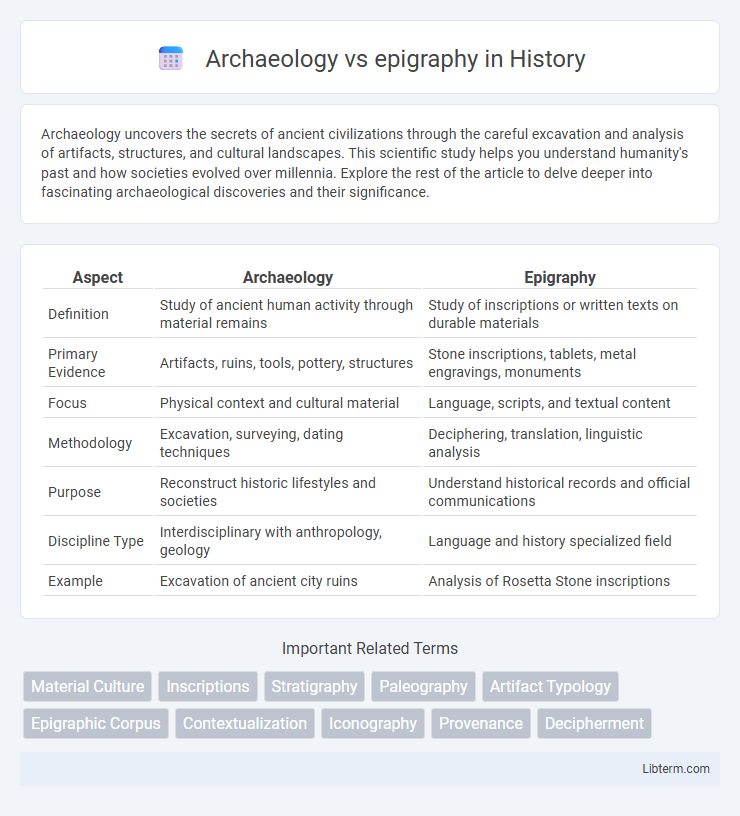Archaeology uncovers the secrets of ancient civilizations through the careful excavation and analysis of artifacts, structures, and cultural landscapes. This scientific study helps you understand humanity's past and how societies evolved over millennia. Explore the rest of the article to delve deeper into fascinating archaeological discoveries and their significance.
Table of Comparison
| Aspect | Archaeology | Epigraphy |
|---|---|---|
| Definition | Study of ancient human activity through material remains | Study of inscriptions or written texts on durable materials |
| Primary Evidence | Artifacts, ruins, tools, pottery, structures | Stone inscriptions, tablets, metal engravings, monuments |
| Focus | Physical context and cultural material | Language, scripts, and textual content |
| Methodology | Excavation, surveying, dating techniques | Deciphering, translation, linguistic analysis |
| Purpose | Reconstruct historic lifestyles and societies | Understand historical records and official communications |
| Discipline Type | Interdisciplinary with anthropology, geology | Language and history specialized field |
| Example | Excavation of ancient city ruins | Analysis of Rosetta Stone inscriptions |
Introduction to Archaeology and Epigraphy
Archaeology studies ancient human activity through artifacts, architecture, and cultural landscapes to reconstruct past societies and understand historical developments. Epigraphy focuses on the analysis and interpretation of inscriptions engraved on durable materials, providing direct textual evidence of historical events, languages, and customs. Together, archaeology and epigraphy offer complementary insights into ancient civilizations, combining material culture with written records for comprehensive historical research.
Defining Archaeology: Scope and Methods
Archaeology involves the systematic study of human history and prehistory through excavation and analysis of material remains, including artifacts, structures, and biofacts. Its scope encompasses uncovering physical evidence to reconstruct past societies, employing methods like stratigraphy, radiocarbon dating, and geophysical surveys. Unlike epigraphy, which specializes in interpreting inscriptions and written records, archaeology provides a broader context by integrating environmental and cultural data to understand ancient civilizations comprehensively.
Understanding Epigraphy: Focus and Techniques
Epigraphy specializes in the study of inscriptions engraved on durable materials such as stone, metal, or pottery, providing direct evidence of ancient languages, scripts, and historical events. Techniques in epigraphy include detailed recording methods like squeezes, digital imaging, and 3D scanning, which enhance the readability and preservation of fragile texts. Unlike broader archaeological methods that analyze artifacts and sites, epigraphy focuses on deciphering, dating, and interpreting written records to reconstruct linguistic and cultural histories.
Key Differences Between Archaeology and Epigraphy
Archaeology involves the study of ancient human activity through the excavation and analysis of material remains such as artifacts, structures, and landscapes, emphasizing a broad understanding of past cultures. Epigraphy, on the other hand, specializes in the examination and interpretation of inscriptions or engraved texts on durable materials like stone, metal, or pottery, providing direct historical records and linguistic insights. While archaeology offers a comprehensive view of historical contexts, epigraphy delivers precise information about language, dates, and specific events, making both disciplines complementary but distinct in their approaches to uncovering history.
Overlapping Areas: Archaeological and Epigraphic Collaboration
Archaeology and epigraphy intersect in the analysis of inscribed artifacts, where archaeological context enhances the understanding of epigraphic texts. Collaborative efforts enable precise dating and cultural interpretation by integrating material evidence with inscriptional data. Joint studies of monuments, tombs, and public records reveal socio-political narratives, enriching both archaeological and epigraphic insights.
Tools and Technologies in Archaeology vs Epigraphy
Archaeology utilizes tools such as ground-penetrating radar (GPR), LiDAR, and digital mapping technologies to excavate and analyze physical sites, while epigraphy relies heavily on high-resolution 3D imaging, Reflectance Transformation Imaging (RTI), and multispectral imaging to decipher and preserve ancient inscriptions. Advanced software for pattern recognition and linguistic analysis enhances epigraphic studies by accurately interpreting worn or damaged texts. Both fields increasingly integrate Geographic Information Systems (GIS) and digital databases to document findings and facilitate interdisciplinary research.
Case Studies: Insights from Archaeological Finds and Epigraphic Evidence
Case studies reveal that archaeological finds, such as pottery shards and settlement remains, provide tangible context for understanding ancient cultures, while epigraphic evidence, including inscriptions and written records, offers precise historical details and language insights. In the excavation of Pompeii, artifacts unveiled daily life and urban organization, whereas wall inscriptions supplied names, dates, and official decrees, enriching historical reconstruction. Combining these disciplines allows scholars to cross-verify data, yielding a more comprehensive picture of past civilizations.
Challenges Faced in Archaeology and Epigraphy
Archaeology faces challenges such as site degradation, limited context preservation, and difficulties in accurately dating artifacts. Epigraphy struggles with incomplete inscriptions, language decipherment, and the contextual interpretation of ancient texts. Both disciplines require meticulous analysis to reconstruct historical narratives from fragmented evidence.
The Role of Archaeology and Epigraphy in Reconstructing History
Archaeology uncovers physical artifacts and architectural remains that provide tangible evidence of past civilizations, while epigraphy studies inscriptions to interpret written records and languages. Together, archaeology and epigraphy enable a comprehensive reconstruction of history by correlating material culture with textual data, revealing societal, political, and economic aspects of ancient life. The integration of archaeological context with epigraphic analysis validates historical timelines and enriches understanding of human development.
Future Trends in Archaeological and Epigraphic Research
Future trends in archaeological and epigraphic research emphasize the integration of advanced technologies such as AI-driven image recognition, 3D scanning, and remote sensing to enhance site discovery and inscription analysis. Increased use of digital databases and machine learning algorithms accelerates the decoding and contextualization of ancient texts, improving access and interpretative accuracy. Collaborative interdisciplinary approaches combining geospatial data, materials science, and linguistic analysis are revolutionizing the understanding of cultural and historical contexts in both fields.
Archaeology Infographic

 libterm.com
libterm.com